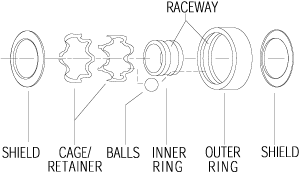| Available Bearings | Bearing Selector | Technical Info | New Products | |||
Ball Bearing Nomenclature || Dynaroll's Technical Overview of Bearings
TECHNICAL INFORMATION
Overview & Nomenclature
Materials
Cages/Retainers
Shields and Seals
Ball Bearings - Geometry
Ball Bearings - Tolerances
Ball Bearings - Lubrication
Load Rating and Bearing Lifetime
Ball Bearings - Torque
Ball Bearings - Noise
Mounting and Fitting
Assembly Preload
Ball Bearing Handling
Adhesive Practices
Assembly Characteristics
Useful Conversions
Interested in Mechanical Assemblies?
Read our Quality Policy
OVERVIEW & NOMENCLATURE
BALL BEARING OVERVIEW
Ball bearings are rotational components that contribute to the high performance and long lifetime of mechanical assemblies. In all but the most low-end of products, bearings are used with parts that need to rotate. Different types of bearings exist for different purposes: standard roller ball bearings, shielded bearings, sealed bearings, thrust bearings, collar bearings and flangette collar bearings. Bearings can be found in many household items, from blenders to drawer slides to computer disk drives.
Bearings are specified to handle certain maximum amounts of radial and axial (thrust) loads. Typically, ball bearings transfer their loads from their outer races to the balls, then from the balls to their inner races. Since the balls are spheres, they only make contact with the inner and outer races at very limited points, a characteristic that allows the bearings to spin smoothly. Because of a bearing's limited contact area, it can be easily overloaded leading to deformation (i.e. ball flattening), poor performance and eventual failure, so it is important for the person selecting bearings to check load ratings and other parameters.
Single-row deep groove ball bearings are the most common type of rolling bearing, having a wide range of suitable applications. The raceway grooves on both inner and outer rings have circular arcs of slightly larger radius than that of the balls. In addition to radial loads, axial loads can be applied in either direction. Because of their low torque, they offer high speed operation with low power loss.
Miniature and instrument bearings are made with very high levels of precision, therefore these are generally used in applications where accurate rotational performance and low torque is necessary and where load capacity is a secondary issue.

